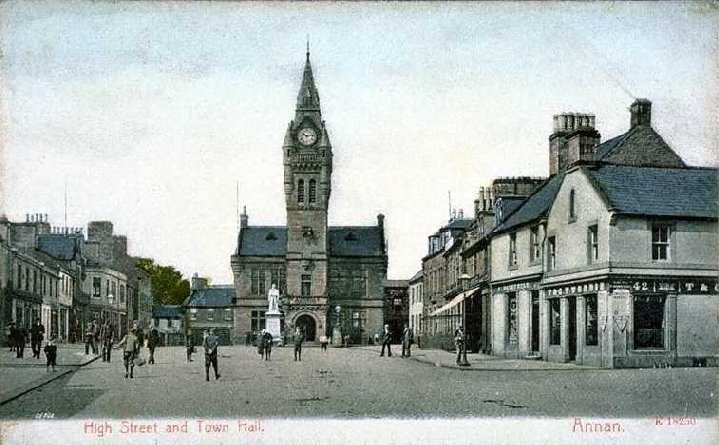BORDER TOWNS
annan
Annan Lies on the Scottish side of the Solway Firth overlooking the English coast, with the mountains of the Lake District beyond.
During the days of the Wars for Independence, across this shallow estuary, came invading English armies time and again, ravishing Annandale and beyond. Then came the border reivers, mainly by land, adding to the misery of the long suffering people.
Not all the bloodshed resulted from foreign enemies. Bitter clan feuding went on for centuries, long after the original causes were forgotten. Particularly vicious was the ongoing feuding involving the Maxwells and the Johnstones.
Originally, Annan was a market town being a focus for the distribution of the produce from the rich farming land of the region. Grain was milled and imported cotton was spun and lucrative trade was established with America.
Ships were built at Annan, including the tea clippers, some vessels being 100 tons in size. Today nothing remains but a rather dejected harbour. But still can be seen are the piers where many Scots people boarded ships to take them to a new life overseas.
Not long ago a railway viaduct crossed the Solway at Annan. It was demolished in 1935 and the approaches can still be seen. Still surviving is the railway station, the railway being built in 1848 by the Glasgow and South Western Railway.
Housed in a magnificent red sandstone building is Annan's Historic Resources Centre, with its small but interesting museum and extensive archive section.
Annan library has useful reference books relating to the history of Annan and the surrounding region. It holds many other records including local cemetery gravestone inscriptions. There is a wide range of facilities including internet access.
This is Maxwell territory. For those with family connection there is a Family History Society with extensive resources. Also with associations in this region are the Irvines, Carlisles, Bells, Carruthers, Johnstones, and the Armstrongs.
Annan stands on the north bank of the Solway Firth which is bounded by acres of treacherous sands which are only visible at low tide. There are patches of dangerous quicksands which have claimed countless lives. When the tide flows the speed at which the water comes in is greater than the speed of a running man.
Reiving bands made use of the elements of danger and became skilled at making safe crossings in both directions much to the despair of the people of Annan and surrounding districts.
From the 18th century irregular and runaway marriage 'ceremonies' were held at the Blue Bell Inn.

Annan High Street from an old print
Around and About
Dumfries
Hoddam Castle